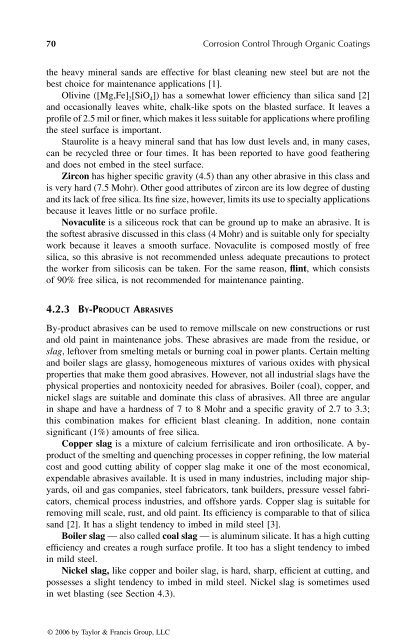© 2006 by Taylor & Francis Group, LLC
© 2006 by Taylor & Francis Group, LLC
© 2006 by Taylor & Francis Group, LLC
Create successful ePaper yourself
Turn your PDF publications into a flip-book with our unique Google optimized e-Paper software.
70 Corrosion Control Through Organic Coatings<br />
the heavy mineral sands are effective for blast cleaning new steel but are not the<br />
best choice for maintenance applications [1].<br />
Olivine ([Mg,Fe] 2[SiO 4]) has a somewhat lower efficiency than silica sand [2]<br />
and occasionally leaves white, chalk-like spots on the blasted surface. It leaves a<br />
profile of 2.5 mil or finer, which makes it less suitable for applications where profiling<br />
the steel surface is important.<br />
Staurolite is a heavy mineral sand that has low dust levels and, in many cases,<br />
can be recycled three or four times. It has been reported to have good feathering<br />
and does not embed in the steel surface.<br />
Zircon has higher specific gravity (4.5) than any other abrasive in this class and<br />
is very hard (7.5 Mohr). Other good attributes of zircon are its low degree of dusting<br />
and its lack of free silica. Its fine size, however, limits its use to specialty applications<br />
because it leaves little or no surface profile.<br />
Novaculite is a siliceous rock that can be ground up to make an abrasive. It is<br />
the softest abrasive discussed in this class (4 Mohr) and is suitable only for specialty<br />
work because it leaves a smooth surface. Novaculite is composed mostly of free<br />
silica, so this abrasive is not recommended unless adequate precautions to protect<br />
the worker from silicosis can be taken. For the same reason, flint, which consists<br />
of 90% free silica, is not recommended for maintenance painting.<br />
4.2.3 BY-PRODUCT ABRASIVES<br />
By-product abrasives can be used to remove millscale on new constructions or rust<br />
and old paint in maintenance jobs. These abrasives are made from the residue, or<br />
slag, leftover from smelting metals or burning coal in power plants. Certain melting<br />
and boiler slags are glassy, homogeneous mixtures of various oxides with physical<br />
properties that make them good abrasives. However, not all industrial slags have the<br />
physical properties and nontoxicity needed for abrasives. Boiler (coal), copper, and<br />
nickel slags are suitable and dominate this class of abrasives. All three are angular<br />
in shape and have a hardness of 7 to 8 Mohr and a specific gravity of 2.7 to 3.3;<br />
this combination makes for efficient blast cleaning. In addition, none contain<br />
significant (1%) amounts of free silica.<br />
Copper slag is a mixture of calcium ferrisilicate and iron orthosilicate. A <strong>by</strong>product<br />
of the smelting and quenching processes in copper refining, the low material<br />
cost and good cutting ability of copper slag make it one of the most economical,<br />
expendable abrasives available. It is used in many industries, including major shipyards,<br />
oil and gas companies, steel fabricators, tank builders, pressure vessel fabricators,<br />
chemical process industries, and offshore yards. Copper slag is suitable for<br />
removing mill scale, rust, and old paint. Its efficiency is comparable to that of silica<br />
sand [2]. It has a slight tendency to imbed in mild steel [3].<br />
Boiler slag — also called coal slag — is aluminum silicate. It has a high cutting<br />
efficiency and creates a rough surface profile. It too has a slight tendency to imbed<br />
in mild steel.<br />
Nickel slag, like copper and boiler slag, is hard, sharp, efficient at cutting, and<br />
possesses a slight tendency to imbed in mild steel. Nickel slag is sometimes used<br />
in wet blasting (see Section 4.3).<br />
<strong>©</strong> <strong>2006</strong> <strong>by</strong> <strong>Taylor</strong> & <strong>Francis</strong> <strong>Group</strong>, <strong>LLC</strong>
















